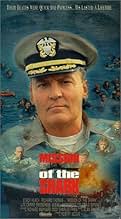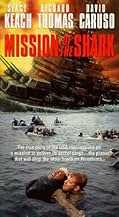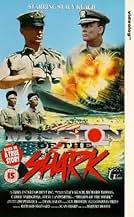Nom de code: Requin
Original title: Mission of the Shark: The Saga of the U.S.S. Indianapolis
IMDb RATING
6.3/10
1K
YOUR RATING
True story of the sinking of the U.S.S. Indianapolis, its crew's struggle to survive the sharks and exposure, and the captain's scape-goat court-martial.True story of the sinking of the U.S.S. Indianapolis, its crew's struggle to survive the sharks and exposure, and the captain's scape-goat court-martial.True story of the sinking of the U.S.S. Indianapolis, its crew's struggle to survive the sharks and exposure, and the captain's scape-goat court-martial.
Joseph Carberry
- Spilner
- (as Joe Carberry)
- Director
- Writer
- All cast & crew
- Production, box office & more at IMDbPro
Featured reviews
This is my first review, but I feel I must say something. Having just finished reading Doug Stanton's In Harm's Way, I see important opportunities missed in this film. There were true details omitted - probably for time's sake - that would have made this a more memorable film. For example, when the plane approaches a group of survivors, the crew seriously wonders who they are because their faces are smudged black from the huge oil slick that we never see in the film. As a test, a crew member calls out, "What city do the Dodgers play in?" A feeble voice answers, "Brooklyn." Wouldn't that have been a vintage, human touch?
Dr. Lewis Haynes, incorrectly named as mentioned by other reviewers, had a powerful but ignored role in helping the men to heal psychologically by explaining at reunions why so many turned on each other and acted like barbarians in the water. Most had been unaware that they were witnessing not the moral failings of their friends, but instead the effects of salt water ingestion, exposure to extreme heat, continuous lowering of body temperature, horrific fear, etc., on both body and mind. Add to that survivors' guilt and the Navy's total lack of caring. At that time nobody knew of PTSD.
Thus I mourn for what could have been done in this film. The one bright spot was Stacy Keach's acting. He was masterful and at his finest.
I believe we owe it to those who survived as well as to those who perished, and to their loved ones, to tell this story again on film, and GET IT RIGHT!
Dr. Lewis Haynes, incorrectly named as mentioned by other reviewers, had a powerful but ignored role in helping the men to heal psychologically by explaining at reunions why so many turned on each other and acted like barbarians in the water. Most had been unaware that they were witnessing not the moral failings of their friends, but instead the effects of salt water ingestion, exposure to extreme heat, continuous lowering of body temperature, horrific fear, etc., on both body and mind. Add to that survivors' guilt and the Navy's total lack of caring. At that time nobody knew of PTSD.
Thus I mourn for what could have been done in this film. The one bright spot was Stacy Keach's acting. He was masterful and at his finest.
I believe we owe it to those who survived as well as to those who perished, and to their loved ones, to tell this story again on film, and GET IT RIGHT!
An accurate portrayal of the sinking of USS Indianapolis and worthwhile for telling a tale of survival under the most desperate conditions which can be imagined. Also the most damning indictment of leadership failure since Tennyson's Charge of the Light Brigade.
It was my misfortune, and that of the US Navy, that I viewed this production less than 3 days before I was to report to RECTRACOMGLAKES to begin what I expected to be my naval career. My confidence in the superiors appointed over me was shattered, particularly in Officers O-6 and above who might be reasonably expected not to misplace something as substantial as a heavy cruiser. My service was short, to my regret.
As for the court-martial of CAPT C.B. McVey, the practice of choosing a scapegoat in the aftermath of preventable disaster causing great loss of life appears to be endemic in the USN. Decades later, in the wake of the gun turret explosion aboard USS Iowa, naval investigators fabricated a fantastic tale of 'gay romance run amok' as the cause.
In the near twenty years gone by I hope that things have improved in the Navy. Most, enlisted and officers alike serve with great dedication and professionalism. Unfortunately a few bad apples spoils the barrel.
jHh
It was my misfortune, and that of the US Navy, that I viewed this production less than 3 days before I was to report to RECTRACOMGLAKES to begin what I expected to be my naval career. My confidence in the superiors appointed over me was shattered, particularly in Officers O-6 and above who might be reasonably expected not to misplace something as substantial as a heavy cruiser. My service was short, to my regret.
As for the court-martial of CAPT C.B. McVey, the practice of choosing a scapegoat in the aftermath of preventable disaster causing great loss of life appears to be endemic in the USN. Decades later, in the wake of the gun turret explosion aboard USS Iowa, naval investigators fabricated a fantastic tale of 'gay romance run amok' as the cause.
In the near twenty years gone by I hope that things have improved in the Navy. Most, enlisted and officers alike serve with great dedication and professionalism. Unfortunately a few bad apples spoils the barrel.
jHh
A true story worth telling, this movie suffers heavily from contrived dialog which was obviously written by someone unfamilar with the Navy. It's a classic example of writers who have learned most of what they think they know about their subject matter from watching previous movies which were just as likely written by still other writers who learned from watching still earlier movies, ad infinitum. The use of an Iowa-class battleship to portray an obsolescent pre-war heavy cruiser less than one-third its size didn't help, either.
One technical point: speaking as a former submariner and current submarine museum director, speed was always generally regarded a significant defense to submarine attack, and given the technology available at the time it was just plain bad luck as much as anything else that the Japanese were actually able to hit the INDIANAPOLIS. Note also that the submarine had to fire a total of six torpedoes to achieve two hits.
One last point: speaking as the survivor of a vicious wild-animal attack, I can attest that the fear of it is infinitely worse than its physical reality, and I could easily come up with a long list of worse ways to go - surely one would suffer worse from dehydration and exposure, to say nothing of what the medical profession is capable of doing to you once you get to a hospital.
***SPOILER ALERT *** Incidentally, McVay never recovered from the sinking. He committed suicide in 1968. In 2000 the United States Congress passed and the President signed a formal resolution exonerating him from blame for the sinking.
One technical point: speaking as a former submariner and current submarine museum director, speed was always generally regarded a significant defense to submarine attack, and given the technology available at the time it was just plain bad luck as much as anything else that the Japanese were actually able to hit the INDIANAPOLIS. Note also that the submarine had to fire a total of six torpedoes to achieve two hits.
One last point: speaking as the survivor of a vicious wild-animal attack, I can attest that the fear of it is infinitely worse than its physical reality, and I could easily come up with a long list of worse ways to go - surely one would suffer worse from dehydration and exposure, to say nothing of what the medical profession is capable of doing to you once you get to a hospital.
***SPOILER ALERT *** Incidentally, McVay never recovered from the sinking. He committed suicide in 1968. In 2000 the United States Congress passed and the President signed a formal resolution exonerating him from blame for the sinking.
This film is nicely filmed, though probably purposefully has the feel and look (and dialog) of a movie made in the 50s or 60s. Since the beginning and end are set in the 60s, I suspect that it was done on purpose. Scenes on the Indianapolis are fairly well done. The acting is a little stiff throughout, which is mostly due to a rather dry, stiff dialog and unimaginative script. They do manage to get the viewer steamed up at the Navy at the Court Marshall of Captain McVay. The film leaves a bit to be desired, but the saddest part of the tale is that the horror is true and teh abhorent behavior of the US Navy was unforgivable, even as of 1991. I have no idea whether the record or memory of McVay has been cleared since, but it certainly should be. The film makes a strong statement about the horrible costs of war.
I saw this film when it was first aired... Since then I have been interested in the story of the tragedy. This book has recently been published about the sinking, "In Harm's Way: The Sinking of the USS Indianapolis and the Extraordinary Story of Its Survivors" by Doug Stanton. I recommend this book to anyone who would like to know the complete story with the most current information. This will probably be the last book with new interviews from survivors as source material.
Did you know
- TriviaThis is the very mission that Quint (Robert Shaw) talked about being a member of in a famous scene from Jaws (1975).
- GoofsIn the scene where a seaplane lands at sea to rescue the crew, the plane used is a Grumman Albatross. However, this aircraft was not put into service until 1949. The real life aircraft that rescued the crew, was a Catalina PBY.
- Quotes
Hashimoto: Captain. You are a man who believes in fate?
Capt. Charles Butler McVay: No. I'm a man who was trying to accept it.
Hashimoto: It is not easy being a survivor.
- Crazy credits(Contents of Title Card 1) Following the U.S.S. Indianapolis tragedy the U.S. Navy discontinued its policy of not reporting arriving non-combat ships.
- ConnectionsEdited from Enola Gay (1980)
Details
Contribute to this page
Suggest an edit or add missing content



































